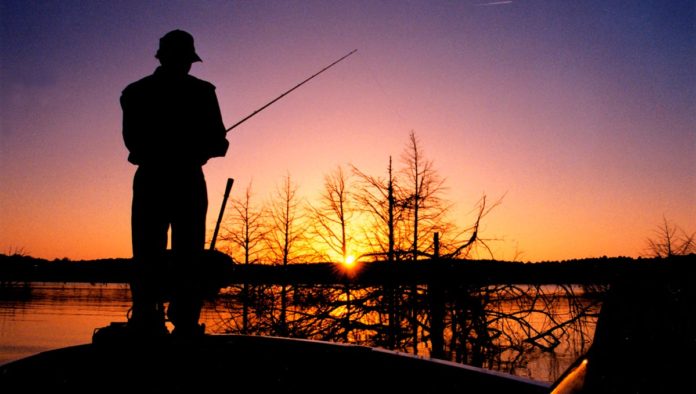Grappling with flathead catfish: An Oklahoma noodling adventure
David Dishman and Ed Godfrey waded through a creek for a noodling adventure. Noodlers use their bare hands, and some times feet, to catch flathead catfish.
Jordan Green and Paige Dillard, Oklahoman
Oklahoma’s new fishing regulation, which will allow black bass anglers to keep smaller fish but limit the harvest of bigger fish, goes into effect on Sept. 11.
It’s a change in bass management strategy that the Oklahoma Department of Wildlife Conservation has practiced for almost 40 years, moving from a catch-and-release philosophy to encouraging the catch-and-keep of small bass.
The new rule will remove the statewide 14-inch minimum length limit on lakes and allow anglers to keep only one black bass daily greater than 16 inches. State fishing biologists say the new regulation is meant to motivate anglers to keep and eat small bass to improve the overall health of the bass populations in the lakes.
Black bass are largemouth, smallmouth and spotted bass. There already is no minimum length limit on spotted bass to encourage harvest of those fish.
In the 1970s and ’80s, the catch-and-release mindset promoted by the bass tournament industry took over the bass fishing world. It eventually became “kind of taboo about keeping a bass,” said Josh Johnston, northeast fisheries supervisor for the Oklahoma Department of Wildlife Conservation.
“We went from keeping about every bass we catch to nearly releasing just about every bass we catch,” Johnston said.
More:Oklahoma dove season opens, signaling start of the fall hunting seasons
The result has been bass populations in Oklahoma’s lakes being dominated by fish that measure 14 inches or less in length, Johnston said. All of the smaller fish competing for a finite supply of food has resulted in extremely low bass growth in many Oklahoma lakes, he said.
By having anglers remove more of the smaller bass from the lakes, the hope is there will be more food sources for fewer fish and it will improve the growth rate of bass.
“All it (the 14-inch minimum length limit) is doing is increasing competition at smaller sizes which can lead to slow growth, or in some really bad cases stunting (fish that have stopped growing),” Johnston said. “The resources have to be plentiful enough for the fish to do well. A minimum length limit is just not useful for us.”
Almost all of the lakes in Oklahoma had a 14-inch minimum length limit for the past 30 to 40 years, Johnston said. It eventually became a statewide regulation for all lakes except those with slot limits, he said.
The new rule will still allow for a daily limit of six bass, but only one can be greater than 16 inches in length. The new regulation excludes rivers and streams, Lake Texoma (since it is partly under Texas control) and Doc Hollis Lake on the Sandy Sanders Wildlife Management Area.
Bass tournaments can get an exception to the rule, which will allow tournament anglers to possess more than one bass more than 16 inches as long as the fish is alive and released after the weigh-in.
Tournament directors must get a tournament exception for all participating anglers through the Go Outdoors App or at GoOutdoorsOklahoma.com. The bass tournament director is responsible for distributing exemption permits to tournament anglers.
Any bass tournament happening on Sept. 11 and afterward will need an exemption for its participants to be able to keep more than one fish greater than 16 inches.
Tournament exemptions will be issued no earlier than two weeks prior to the tournament date. One day and multi-day exemptions are available for bass tournaments.
Each separate tournament will need an exemption permit. Weekly series jackpots events will need a permit for each week.
More:Looking for more hiking trails in Oklahoma? Here are seven other places to visit
Teal, goose season set to open
Oklahoma’s September teal hunting season will open Sept. 10 and run through Sept. 25 statewide. The daily limit is six.
Blue-winged teal and green-winged teal usually migrate through Oklahoma much earlier than many other ducks, so waterfowlers are offered the chance to hunt the birds before the regular duck seasons open.
Duck season in the Panhandle will open Oct. 8. Duck season will open Nov. 12 in the rest of the state.
The state’s resident Canada goose season also will open Sept. 10 and run through Sept. 19 statewide. The daily limit is eight.
Drawings for duck blinds on Eufaula, Fort Gibson, W.D. Mayo and Webbers Falls reservoirs will be Sept. 17 at the Wildlife Department’s office in Porter. All waterfowlers are urged to pre-register for their desired lake at GoOutdoorsOklahoma.com but registration on site will be allowed.
The drawing for blinds on Fort Gibson Lake will begin at 7:30 a.m., with the Lake Eufaula drawing following at 9:30 a.m. The drawing for Webbers Falls will begin at 11:30 a.m., and the drawing for spots on W.D. Mayo Lake near Spiro will be held at 1 p.m. Check-in and registration begins 30 minutes before each of the drawings.
More:Where are the best hiking trails in Oklahoma? Try out these places this fall
Jones angler writes second book
A Jones angler has written his second fishing book.
In 2020, Tom Friedemann published “If It Were Easy, They’d Call It Catchin.” The book was based on the 74-year-old angler’s fishing journal that he kept his entire life.
He caught his first fish in 1957, at age 9, and he has been hooked ever since.
Throughout his life, Friedemann has kept a record of each fish he has caught, the day it was caught, where it was caught, how it was caught, and the bait and tackle used to catch it. He even journaled the weather and water conditions each time.
Now, Friedemann has published a second book of memories titled “Bent Poles, Happy Souls: Fishing Stories Gleaned from Sixty Years of Journaling.”
“It was much easier,” Friedemann said of writing the second book. “The second book, what I really wanted to do is to expand on what people stereotypically think fly fishing is. That was my goal.
“Everybody thinks fly fishing is either for bluegill or trout. I wanted to get into the carp, catfish, crappie and bass. A lot of people don’t think you can catch bass on a fly rod.”
Friedemann is the former chief executive officer and superintendent of the Francis Tuttle Technology Center.
More:How will weather affect Oklahoma’s deer population? Bucks could have smaller antlers this fall
Credit: Source link































